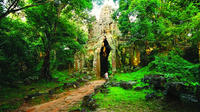Angkor Private Tour
Krong Siem Reap, Cambodia
Trip Type: Private Sightseeing Tours
Duration: 8 hours
Stare in awe at the mother of all temples, Angkor Wat and succumb to the enigmatic smiles of the 216 giant faces of the Bayon, Angkor’s strangest temple. Experience nature running riot at the mysterious ruin of Ta Prohm, the original Tomb Raider temple and discover the secrets of Bar street, Siem Reap’s party capital where the action goes on all night and Angkor Night Market.
More About This Activity All Private Sightseeing Tours →
Stare in awe at the mother of all temples, Angkor Wat and succumb to the enigmatic smiles of the 216 giant faces of the Bayon, Angkor’s strangest temple. Experience nature running riot at the mysterious ruin of Ta Prohm, the original Tomb Raider temple and discover the secrets of Bar street, Siem Reap’s party capital where the action goes on all night and Angkor Night Market.After meeting our tour guide, then we drive to Angkor Thom that was the masterpiece of King Jayavarman VII. Following the occupation of Angkor by the Chams from 1177 to 1181, the new king decided to build an impregnable fortress at the heart of his empire. The scale is simply staggering and we are immediately overwhelmed by the audacity of Jayavarman on arrival at the city’s gates.
We begin to visit Bayon Temple. At the exact centre of Angkor Thom, this is an eccentric expression of the creative genius and inflated ego of Cambodia’s most celebrated king. Its 54 towers are each topped off with the four faces of Avalokiteshvara (Buddha of Compassion), which bear more than a passing resemblance to the king himself. These colossal heads stare down from every side, exuding power and control with a hint of compassion, just the mix required to keep a hold on such a vast empire.
We continue to visit Terrace of the Leper King. This intricately carved platform was the royal crematorium and the statue that was originally thought to be the leper king is now believed to be Yama, the god of death. We continue along the Terrace of Elephants, originally used as a viewing gallery for the king to preside over parades, performances and traditional sports. At the southern end lies the Baphuon, once of the most beautiful temples at Angkor, dating from the reign of Uditayavarman 1 in the 11th century. It has undergone a massive renovation by the French and is now once again open for viewing.
We go local restaurant for Lunch.
We visit Ta Prohm "Tomb Raider" fame. Ta Prohm has been abandoned to the elements, a reminder that while empires rise and fall, the riotous power of nature marches on, oblivious to the dramas of human history. Left as it was ‘discovered’ by French explorer Henri Mouhout in 1860, the tentacle-like tree roots here are slowly strangling the surviving stones, man first conquering nature to create, nature later conquering man to destroy.
We journey out to the Mother of all temples, Angkor Wat. Believed to be the world's largest religious building, this temple is the perfect fusion of symbolism and symmetry and a source of pride and strength to all Khmers. Built in the 12th century by King Suryavarman II, this is most famous temple at Angkor. We venture into Angkor Wat to enjoy its magnificence in peace and quiet. We begin by unraveling the mysteries of the bas-reliefs that tell of tales from Hindu mythology and of the glories of the Khmer empire.
We begin to visit Bayon Temple. At the exact centre of Angkor Thom, this is an eccentric expression of the creative genius and inflated ego of Cambodia’s most celebrated king. Its 54 towers are each topped off with the four faces of Avalokiteshvara (Buddha of Compassion), which bear more than a passing resemblance to the king himself. These colossal heads stare down from every side, exuding power and control with a hint of compassion, just the mix required to keep a hold on such a vast empire.
We continue to visit Terrace of the Leper King. This intricately carved platform was the royal crematorium and the statue that was originally thought to be the leper king is now believed to be Yama, the god of death. We continue along the Terrace of Elephants, originally used as a viewing gallery for the king to preside over parades, performances and traditional sports. At the southern end lies the Baphuon, once of the most beautiful temples at Angkor, dating from the reign of Uditayavarman 1 in the 11th century. It has undergone a massive renovation by the French and is now once again open for viewing.
We go local restaurant for Lunch.
We visit Ta Prohm "Tomb Raider" fame. Ta Prohm has been abandoned to the elements, a reminder that while empires rise and fall, the riotous power of nature marches on, oblivious to the dramas of human history. Left as it was ‘discovered’ by French explorer Henri Mouhout in 1860, the tentacle-like tree roots here are slowly strangling the surviving stones, man first conquering nature to create, nature later conquering man to destroy.
We journey out to the Mother of all temples, Angkor Wat. Believed to be the world's largest religious building, this temple is the perfect fusion of symbolism and symmetry and a source of pride and strength to all Khmers. Built in the 12th century by King Suryavarman II, this is most famous temple at Angkor. We venture into Angkor Wat to enjoy its magnificence in peace and quiet. We begin by unraveling the mysteries of the bas-reliefs that tell of tales from Hindu mythology and of the glories of the Khmer empire.
« Go Back

